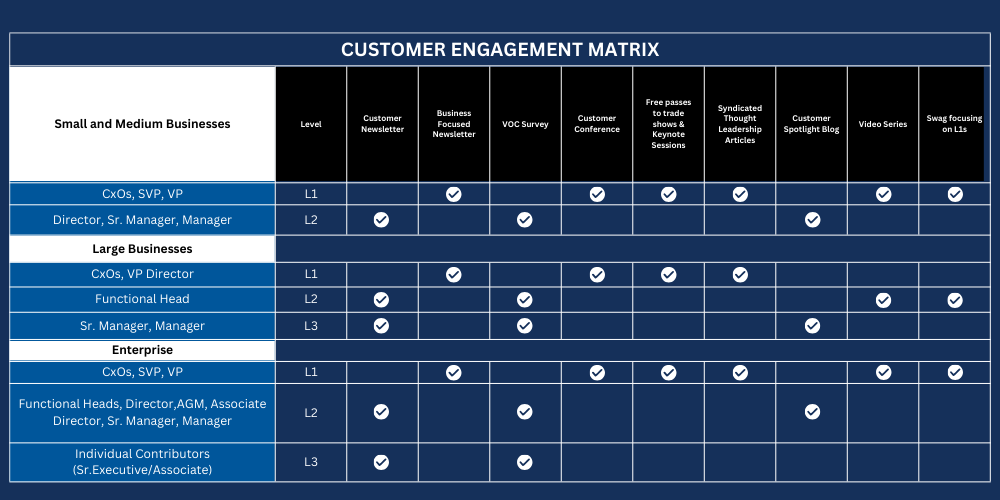Make customers market for you, and you'll never need to do anything else.
Customer marketing has slowly but surely evolved from a buzzword to an important part of the GTM strategy for SaaS businesses. Companies have embraced activities like building communities, case studies, customer roundtables, and more to create excitement and engagement.
However, the real power of customer marketing lies in threading these activities to drive revenue growth.
In this edition of Blume Beacon, we explore the essential aspects of customer marketing, such as:
How can early-stage SaaS companies kickstart their customer marketing journey from day one?
Structuring and scaling a customer marketing team.
Defining KPIs and measuring success.
The boundaries between customer marketing and customer success.
Customer Marketing Decoded: A SaaS Founder's Playbook for Revenue Expansion
In the SaaS world, customer marketing has become a crucial lever for revenue expansion and building deeper customer engagement. Founders recognize the importance of leveraging their customers to drive revenue growth.
We spoke to industry experts Yasasree Nerayanuri, VP of Customer Marketing & Community at Sprinklr, and Raghav Kumar, Head of Marketing at Scribble Data, to develop a customer marketing playbook. Yasasree and Raghav previously built the customer marketing functions from the ground up at Freshworks and CleverTap, respectively.
What is Customer Marketing?
"Customer marketing is marketing with your customers, not to them," says Yasasree. This statement encapsulates the essence of customer marketing – a strategic approach that positions customers as partners in the marketing process, creating a symbiotic relationship.
Raghav outlines the three KPIs of customer marketing: revenue retention, revenue expansion from existing customers, and customer advocacy and evangelism.
Customer Marketing empowers companies to leverage their existing customer base as a powerful marketing asset.
The Case for Early Adoption
Contrary to popular belief, customer marketing is no longer a luxury reserved for mature companies. As Yasasree emphasizes, "You can start on day zero." Early-stage SaaS companies can benefit from customer marketing, even before launching their product.
Starting a community, creating a customer advisory board, developing case studies, and leveraging early customers for investor relations can set the stage for future success. Though these initiatives may not generate revenue, they influence the company's trajectory by attracting investment, building a customer pipeline, and refining the product roadmap based on feedback.
Building a Customer Marketing Foundation
In the early days, avoid hiring a dedicated full-time employee (FTE) for customer marketing.
Raghav recommends starting with a part-time customer marketing person who understands the company's ideal customer profile (ICP) and owns customer marketing as a part of their KRAs.
Yasasree suggests embedding a marketing person in the customer success team to collaborate on account marketing, newsletters, webinars, and press releases involving customers.
Scaling the Customer Marketing Team
As the company grows, Raghav advises following the "10% rule" for resource allocation - Allocate 10% of the customer success team's size, marketing budget, and resources to the customer marketing team.
For instance, if the customer success team has ten members, the customer marketing team has one or two FTEs. Similarly, if the marketing budget for net new revenue is $100,000, at least $10,000 should be allocated to customer marketing.
The DNM Framework: Discover, Nurture, and Mobilize
The DNM (Discover, Nurture, and Mobilize) framework provides a structured approach to effectively scope and execute customer marketing activities:
Discover: Identify customer profiles to target based on company size, industry, or other relevant criteria.
Nurture: Develop a matrix of activities tailored to each customer segment, considering company size, annual contract value (ACV), and decision-maker levels (L1, L2, L3).
Mobilize: Convert customers into champions through nurturing activities, fostering advocacy and evangelism.
The Growth and Advocacy Teams
As customer marketing teams mature, divide responsibilities between growth and advocacy teams.
Growth Team: Focused on driving revenue expansion from existing customers. They analyze customer signals, identify upsell/cross-sell opportunities, and nurture leads for the sales team.
Advocacy Team: Dedicated to building a loyalty program and identifying customer champions. This team creates and scales your customer community through incentives, exclusive benefits, and recognition. This community promotes the brand and informs the product roadmap.
Measuring Impact and Revenue Attribution
Measuring the direct impact of customer marketing on revenue can be challenging, but Yasasree encourages founders to focus on overall revenue influence rather than getting bogged down by attribution debates. She suggests tracking metrics such as marketing-influenced pipeline and overall revenue growth instead of obsessing over individual team attribution.
Customer marketing can provide up to 25x return on investment, depending on the company's stage. Activities like webinars, events, and community building have minimal costs but can attract new prospects and generate substantial revenue opportunities.
The Softer Benefits of Customer Marketing
Besides generating revenue, customer marketing offers important soft benefits. As Raghav notes, customers often view the customer marketing team as an ally within the company, making it easier to get honest feedback for product development.
Moreover, customer marketing bridges product, sales, customer success, and customers, facilitating open communication and understanding across these functions.
Defining Boundaries with Customer Success
While customer marketing and customer success teams collaborate closely, defining clear boundaries and responsibilities is essential. Yasasree recommends keeping Customer Success Managers (CSMs) out of the selling process, allowing them to focus on creating the best product outcomes for customers.
Customer success should build connections within the customer's organization and hand over those relationships to the customer marketing team for nurturing and mobilization. Once the customer is successfully nurtured, the sales team can initiate conversations about upgrades or new products.
To go deeper into the strategies and tactics to fast-track your customer marketing journey, check the full article here.




